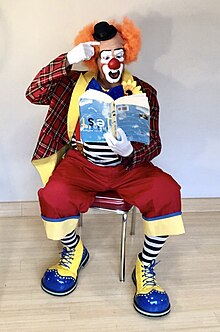
Back Nar Afrikaans Clown ALS مهرج Arabic كلون ARY Payasu AST Kloun Azerbaijani Clown BAR Клоўн Byelorussian Клоун Bulgarian Pallasso Catalan
This article's lead section may be too short to adequately summarize the key points. (September 2023) |
| Clown | |
|---|---|
 A typical clown of the Western "buffoon" tradition | |
| Medium | Physical comedy, acting, mime |
| Types | circus, contemporary circus, comedy, theatre, television, film |
| Ancestor arts | Jester |
| Descendant arts | Harlequinade, comedian |
| Part of a series on |
| Performing arts |
|---|
A clown is a person who performs physical comedy and arts in an open-ended fashion, typically while wearing distinct makeup or costuming and reversing folkway-norms. The art of performing as a clown is known as clowning or buffoonery, and the term "clown" may be used synonymously with predecessors like jester, joker, buffoon, fool, or harlequin. Clowns have a diverse tradition with significant variations in costume and performance. The most recognisable clowns are those that commonly perform in the circus, characterized by colorful wigs, red noses, and oversized shoes. However, clowns have also played roles in theater and folklore, like the court jesters of the Middle Ages and the jesters and ritual clowns of various indigenous cultures. Their performances can elicit a range of emotions, from humor and laughter to fear and discomfort, reflecting complex societal and psychological dimensions. Through the centuries, clowns have continued to play significant roles in society, evolving alongside changing cultural norms and artistic expressions.[1][2][3][4]
- ^ Rogers, Phyllis (1980). "My Favorite Foods are Dr Pepper, Collard Greens, and Pizza. I'm sure I'll Be a Good Clown". ScholarlyCommons. Studies in Visual Communication. 6 (1). University of Pennsylvania: 44–45. doi:10.1111/j.2326-8492.1980.tb00116.x. ISSN 0276-6558. Retrieved 1 January 2021.
Your face was your fortune, and to copy another man's face without his permission was theft, punishable by ostracism. Every man had some kind of special trick which made his makeup look perfect...The old clowns feel that the quickest and easiest way for a person to distinguish between a clown and a person in makeup is the clown's ability to make his face move...The old clowns say that anyone can apply greasepaint to his face but very few practitioners of the art of clowning ever acquire the skill to make their faces move.
- ^ Butler, Laurel (March 2012). "'Everything seemed new': Clown as Embodied Critical Pedagogy". Theatre Topics. 22 (1). Johns Hopkins University Press: 63–72. doi:10.1353/tt.2012.0014. S2CID 191476878. Archived from the original on 29 April 2021. Retrieved 1 January 2021.
Italian clown pedagogue Giovanni Fusetti proposes...conceiving of clown as a state of being...'a state of playing where everyone has access to the key question: what is so funny about myself?' Lecoq describes entering into 'the clown dimension,' which requires 'a state of openness, entirely without defense...a state of reaction and surprise' (146). John Wright...[says] 'the state of bafflement that we see in clown...as a common state of humanity...Clown reminds us that, deep down, we're all in exactly the same bemused state' (218). John Flax (2009)...says that, for Lecoq, 'theatrical clown was just about finding that basic state of vulnerability and allowing the audience to exist in that state with you...A clown state is a state of innocence and poetry and naivety that allows the audience to draw their own conclusions. That's the state that you bring them to, and they'll make the connections or not, but they love to be in that state because we don't go there very often. It's a state of anti-intellectualism, a kind of pure emotion.'
{{cite journal}}: CS1 maint: bot: original URL status unknown (link) - ^ Keisalo, Marianna (24 March 2017). "'Picking People to Hate': Reversible reversals in stand-up comedy". Suomen Antropologi. 41 (4): 62. Retrieved 22 March 2021.
Reversals, broadly defined as switching to the opposite of what is considered 'the normal order' ... Reversals are an important aspect of the performance of many ritual clown figures (Keisalo-Galvan 2011; Steward 1991 [1929]) as well as more everyday instances of clowning and humor (e.g., Basso 1979).
- ^ Double, Oliver (2014) [2005]. "Licence". Getting the Joke: the inner workings of stand-up comedy. Quote by Stewart Lee (2nd ed.). New York: Bloomsbury Methuen Drama. p. 264. ISBN 978-1-4081-7460-9.
According to Stewart Lee, 'By reversing the norms and breaking the taboos, the clowns show us what we have to lose, and what we might also stand to gain, if we stand outside the restrictions of social convention and polite everyday discourse.'